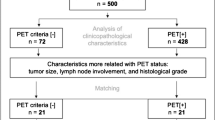Abstract
The aim of this study was to compare the prognostic value of fluorine-18 fluorodeoxyglucose positron emission tomography (FDG PET) with that of second-look laparotomy (SLL) in patients with advanced ovarian carcinoma following primary chemotherapy. Fifty-five patients who had undergone cytoreductive surgery and adjuvant chemotherapy for advanced ovarian carcinoma were enrolled in the study. Thirty patients underwent SLL after primary treatment (SLL group), while 25 underwent FDG PET after primary treatment without SLL (PET group). We retrospectively reviewed the medical records of the 55 patients for comparison of progression-free interval and disease-free interval between the two groups. Ovarian carcinomas recurred in 37 of the 55 patients. When the progression-free interval and the disease-free interval in patients in the PET group were compared with those in the SLL group, no significant differences were observed. The progression-free interval in the PET and SLL groups were 28.8±12.7 months and 30.6±13.7 months, respectively (P=0.29). The disease-free interval in the negative PET group was 40.5±11.6 months, and that in the negative SLL group was 48.6±12.1 months (P=0.12). In conclusion, FDG PET has a similar prognostic value to SLL, and can substitute for SLL in the follow-up of patients who have had ovarian carcinoma, especially when there is a high risk for recurrence.




Similar content being viewed by others
References
Megibow AJ, Bosniak MA, Ho AG, Beller U, Hulnick DH, Beckman EM. Accuracy of CT in detection of persistent or recurrent ovarian carcinoma: correlation with second-look laparotomy. Radiology 1988; 166:341–345.
Rubin SC, Randall TC, Armstrong KA, Chi DS, Hoskins WJ. Ten-year follow-up of ovarian cancer patients after second-look laparotomy with negative findings. Obstet Gynecol 1999; 93:21–24.
Rubinstein E, Knudsen JB. Clinical aspects of second-look laparotomy in ovarian cancer. Ann Chir Gynecol. 1986; 75:177–179.
Podratz KC, Kinney WK. Second-look operation in ovarian cancer. Cancer 1993; 71:1551–1558.
Baram A, Kovner F, Lessing JB, et al. A second though on second look laparotomy. Acta Obstet Gynecol Scand. 1993; 72:386–390.
Obermair A, Sevelda P. Impact of second look laparotomy and secondary cytoreductive surgery in ovarian cancer patients. Acta Obstet Gynecol Scand 2001; 80:432–436.
Sijmons EA, Heintz AP. Second-look and second surgery: second chance or second best? Semin Surg Oncol 2000; 19:54–61.
Cho SM, Ha HK, Byun JY, et al. Usefulness of FDG PET for assessment of early recurrent epithelial ovarian cancer. AJR 2002; 179:391–395.
Wang PH, Liu RS, Li YF, Ng HT, Yuan CC. Whole-body PET with (fluorine-18)-2-deoxyglucose for detecting recurrent primary serous peritoneal carcinoma: an initial report. Gynecol Oncol 2000; 77:44–47.
Torizuka T, Nobezawa S, Kanno T, et al. Ovarian cancer recurrence: role of whole-body positron emission tomography using 2-[fluorine-18]-fluoro-2-deoxy-d-glucose. Eur J Nucl Med Mol Imaging 2002; 29:797–803.
Zimny M, Siggelkow W, Schroder W, et al. 2-[Fluorine-18]-fluoro-2-deoxy -d-glucose positron emission tomography in the diagnosis of recurrent ovarian cancer. Gynecol Oncol 2001; 83:310–315.
Yuan CC, Liu RS, Wang PH, Ng HT, Yeh SH. Whole-body PET with (fluorine-18)-2-deoxyglucose for detecting recurrent ovarian carcinoma. Initial report. J Reprod Med 1999; 44:775–778.
Delbeke D, Martin WH. Positron emission tomography imaging in oncology. Radiol Clin North Am 2001; 39:883–917.
Nakamoto Y, Eisbruch A, Achtyes ED, et al. Prognostic value of positron emission tomography using F-18-fluorodeoxyglucose in patients with cervical cancer undergoing radiotherapy. Gynecol Oncol 2002; 84:289–295.
Rose PG, Faulhaber P, Miraldi F, Abdul-Karim FW. Positron emission tomography for evaluating a complete clinical response in patients with ovarian or peritoneal carcinoma: correlation with second-look laparotomy. Gynecol Oncol 2001; 82:17–21.
Schroder W, Zimny M, Rudlowski C, Bull U, Rath W. The role of 18F-fluoro-deoxyglucose positron emission tomography (18F-FDG PET) in diagnosis of ovarian cancer. Int J Gynecol Cancer 1999; 9:117–122.
Casey MJ, Gupta NC, Muths CK. Experience with positron emission tomography (PET) scans in patients with ovarian cancer. Gynecol Oncol 1994; 53:331–338.
Nakamoto Y, Saga T, Ishimori T, et al. Clinical value of positron emission tomography with FDG for recurrent ovarian cancer. AJR 2001; 176:1449–1454.
Gershenson DM, Copeland LJ, Wharton JT, et al. Prognosis of surgically determined complete responders in advanced ovarian cancer. Cancer. 1985; 55:1129–1135.
de Gramont A, Drolet Y, Varette C, et al. Survival after second-look laparotomy in advanced ovarian epithelial cancer. Study of 86 patients. Eur J Cancer Clin Oncol 1989; 25:451–457.
Luesley DM, Chan KK, Lawton FG, Blackledge GR, Mould JM. Survival after negative second-look laparotomy. Eur J Surg Oncol 1989; 15:205–210.
Author information
Authors and Affiliations
Corresponding author
Rights and permissions
About this article
Cite this article
Kim, S., Chung, JK., Kang, SB. et al. [18F]FDG PET as a substitute for second-look laparotomy in patients with advanced ovarian carcinoma. Eur J Nucl Med Mol Imaging 31, 196–201 (2004). https://doi.org/10.1007/s00259-003-1367-y
Received:
Accepted:
Published:
Issue Date:
DOI: https://doi.org/10.1007/s00259-003-1367-y




